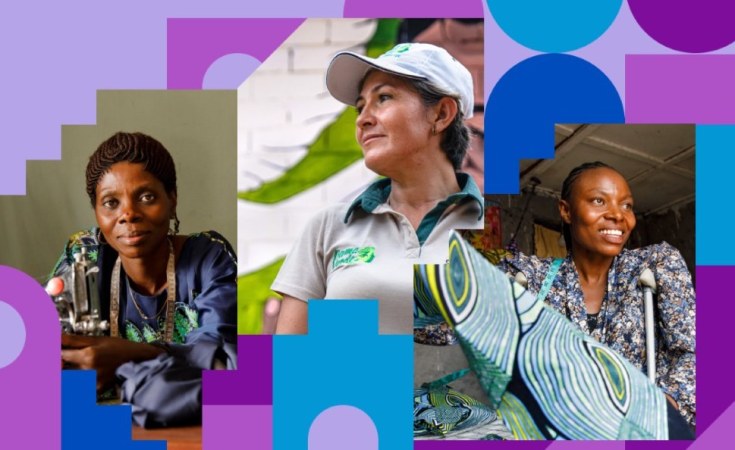Nearly two kilometers into the Indian Ocean from the Mwazaro beach coastline in Lunga Lunga Sub-County, Kwale County, women can be spotted seated in the shallow ocean waters or tying strings to erected poles parallel to the waves. It is a captivating sight to see rows of seaweed farms in the Indian Ocean.
Seaweeds are a group of algae found in seawater and come in green, red, and brown species. The seaweed farms are a predominantly female-dominated form of aquaculture and their owners can only be spotted during low tide, especially in the morning. Once the tide comes in, the women will begin their journey back to the shores as the waters slowly rise.
Saumu Hamadi tells IPS that in 2016, residents of Mwambao village along the Mwazaro beach coastline started a community-led, community-driven initiative to conserve mangroves, protect the environment, and restore their fisheries, which had been destroyed by significant mangrove forest degradation.
"We realized that the more our mangroves disappeared, the fish ran away and so did the fishermen. We rely on fish for food and money. Men sell the big fish, such as the kingfish, shark, and rayfish, to the beach hotels, and women sell crabs and prawns by the roadside or in small village markets. The situation was threatening our daily bread and we decided to volunteer as a community to restore and protect our mangroves," Hamadi explains.
"There were too many people cutting down mangrove trees, destroying the places that the fish we depend on call home. There was also a lot of soil erosion and the water flowing along the River Hamisi that pours into the Indian Ocean within this village's coastline carried the soil into the ocean, polluting it. We formed two community groups: Mwambao Mkuyuni Youth and Bati Beach Mwambao. Women make up 80 percent of the members in both groups."
Abdalla Bidii Lewa, a community coordinator on mangrove restoration in Pongwe Kikoneni ward where Mwambao village is located and chair of Bati Seaweed Farmers, tells IPS, "Mangroves have protected our villages and surrounding areas from extreme weather and disasters such as those that affected large parts of the coastal region during the heavy floods in November and early December 2023. Where houses were swept away and farmlands destroyed, we were safe from the disaster."
Research shows mangroves significantly prevent the progression of climate change while also playing a major role in limiting its impact. This is critical as temperatures rise dangerously, sea level shoots to alarming levels, and coastal climate-induced disasters become frequent, intense, and severe, with catastrophic results.
To avert coastal climate hazards and secure mangrove-related benefits for present and future generations, the community undertook mangrove conservation and restoration activities in earnest.
Then, in 2017, a scientist conducting research into seaweed farming using the off-bottom seaweed farming method--tying algal fonds or seaweed seeds to ropes attached between wooden pegs driven into the ocean sediment--approached women in the community.
"Of the two seaweed strains that grow on Kenya's south coast, cottonii and spinosum, the scientist recommended that we plant spinosum and gave us the seeds. Seaweeds do not need something to grow on. We erect sticks into the ground inside the ocean water during low tides and plant seaweed seeds by tying them to strings fastened on these sticks. We harvest every 45 days. We have to tie the strings and place the sticks properly so that they are not swept away during high tides," says Rehema Abdalla, a seaweed farmer in Mwambao village.
On concerns that aquaculture could form the entry point for mangrove degradation, Hamadi says, "It is not the case with seaweed. The mangroves are important to the survival of our seaweeds by ensuring that we have normal, safe tides and waves. When seaweeds are swept away, they stay trapped within the roots of the mangroves and we collect them from there. It is rare, but once in a while, the tides can be very strong."
Lewa says seaweed farming is emerging as a new and sustainable climate change mitigation strategy while offering communities adjacent to mangroves and coastlines an alternative livelihood, reducing dependency on fishing and natural resources inside mangrove forests and the oceans. Seaweeds are superfoods, highly nutritious, can be used in sushi, soups, salads, and smoothies, and are an asset in the feed industry, cosmetics, and pharmaceuticals.
"The amount of seaweed harvested depends on the amount planted and every 45 days, you will get a harvest. At the moment, one kilogram of seaweed goes for USD 22 (Ksh 35). I am currently targeting making USD 467 (Ksh 75,000) every 45 days from seaweed. We also sell seaweed seeds to other women doing mangrove conservation, such as Imani Gazi and the Gazi Women Mangrove Restoration Group, from within Kwale County," Hamadi says.
Seaweeds compliment mangroves by absorbing nutrients such as nitrogen, phosphorous, and carbon dioxide. They do not require soil, fertilizer, freshwater, or pesticides, and they significantly improve the environment in which they grow. Seaweeds efficiently absorb carbon dioxide, using it to grow and even when harvested, the carbon remains in the ocean.
Research shows that seaweed can pull more greenhouse gases from the water compared to seagrass, salt marshes, and mangroves based on biomass. Mwazaro's beach community is on track to add seaweed as part of their blue carbon sink, setting the pace for other coastal communities.
All the same, the women are facing challenges such as a lack of mortar boats to help transport their harvest to the shore. Currently, they use a tedious process whereby they tie sacks of seaweed on their waste and wait for the onset of high tide in the early afternoon to push them from the seaweed farms to the shore. They are also struggling to access a larger market, currently relying on one major large-scale buyer and small buyers within the village and other mangrove conservation groups from neighboring villages.
IPS UN Bureau Report
This feature is published with the support of Open Society Foundations.


